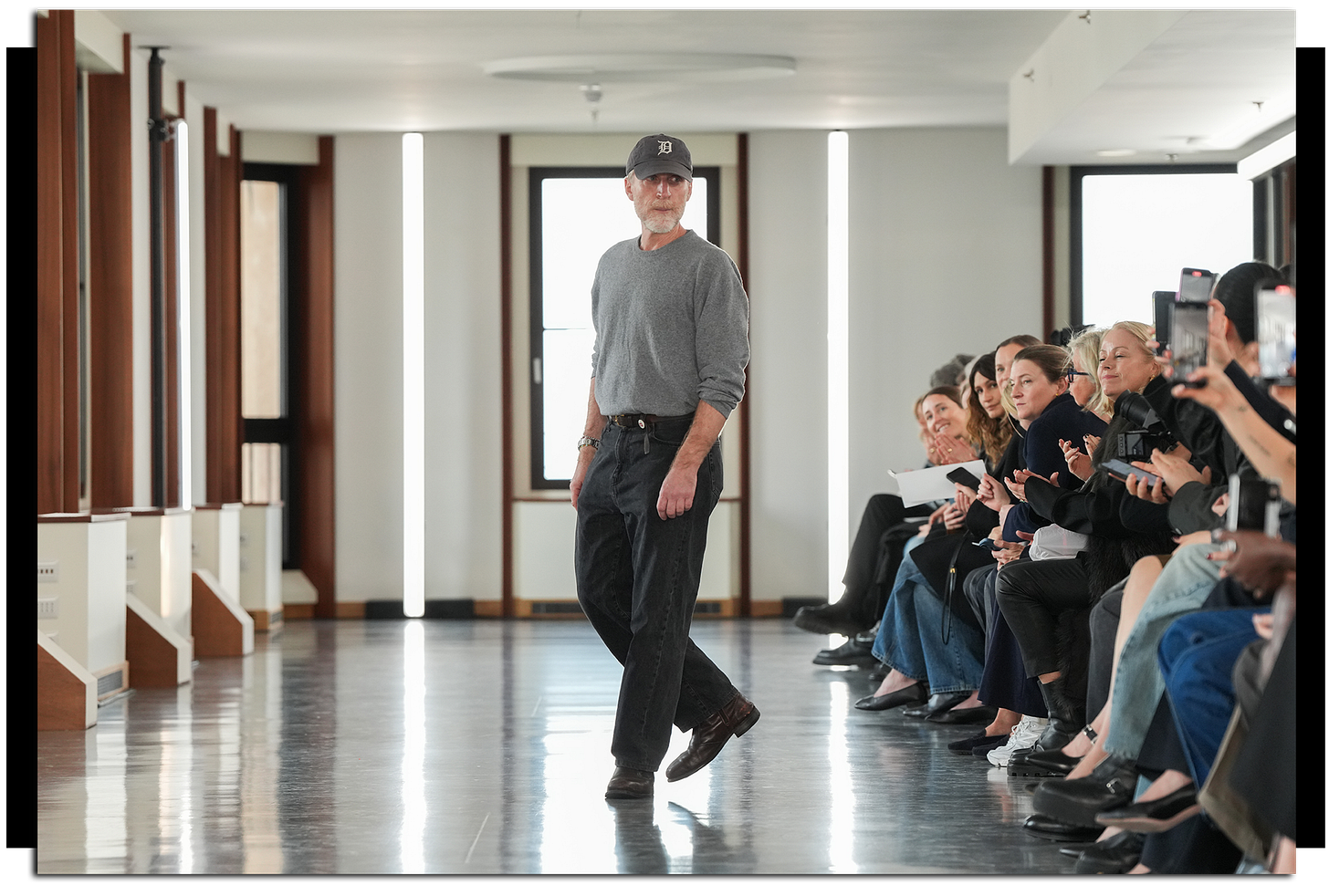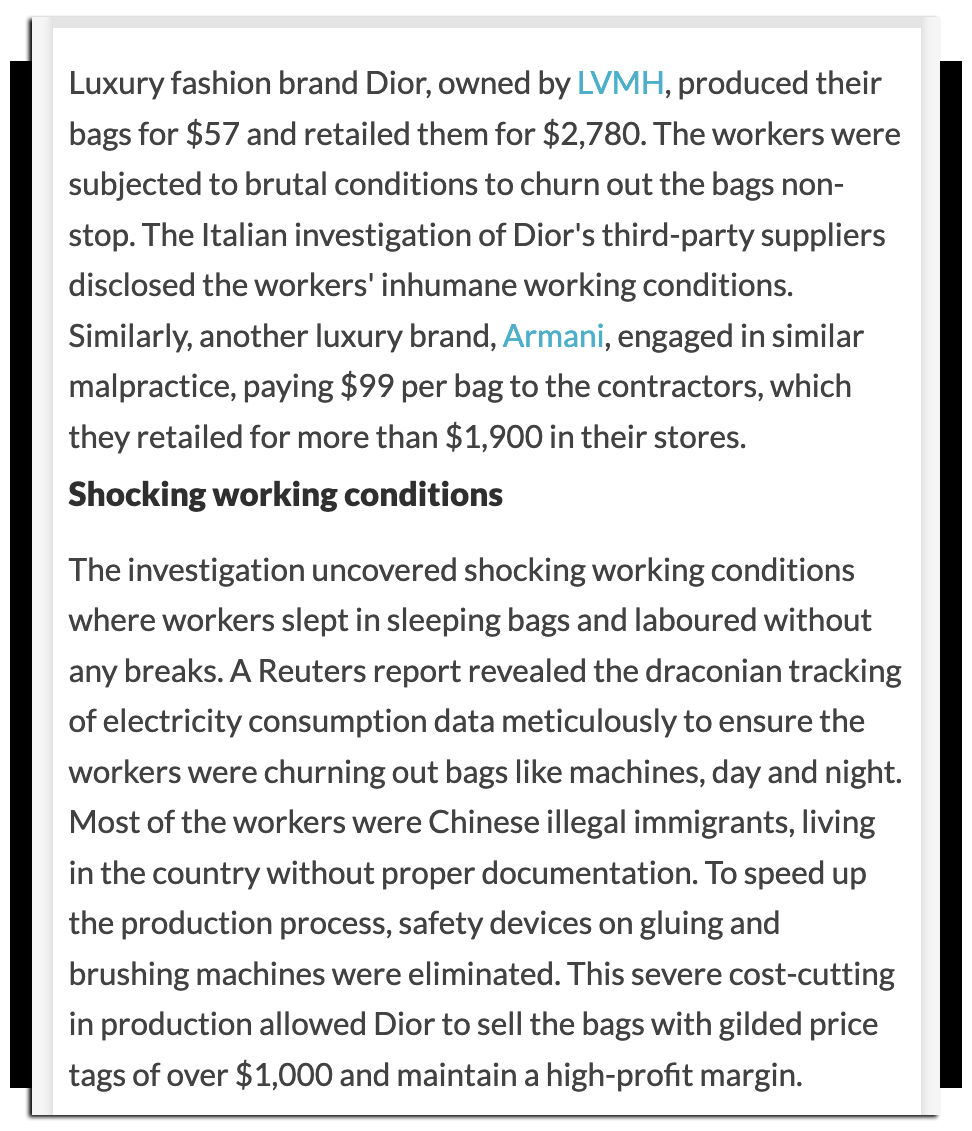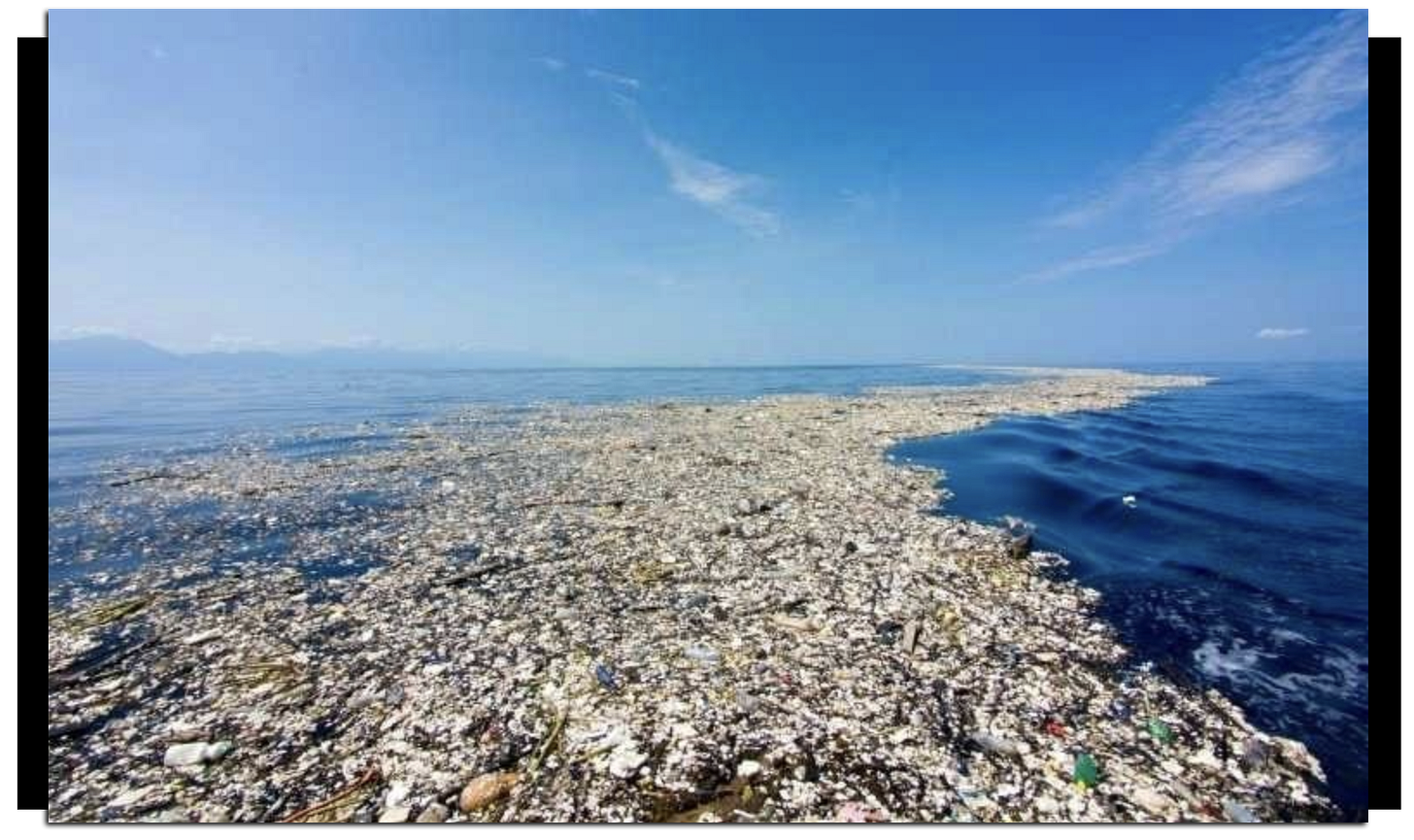Power moves on Garbage Mountain
How to think about "designer musical chairs"
Welcome to Blackbird Spyplane.
Our Home Goods Report, full of things to enliven the place you live and stores where you can find them, is here.
Mach 3+ city intel for traveling the entire planet is here.
The B.L.I.S.S. List — a helpful rundown of Beautiful Life-Improving Spyplane Staples, from incense to sweatpants to underwear — is here.
A Blackbird Spyplane Core Proposition is that we celebrate great clothes made at small scales. We tend not to write much about clothes from enormous brands, which — since we’re a fully reader-powered miracle with zero advertisers to placate — we feel no pressure to pretend are interesting or cool in the vast majority of cases when they aren’t.
So we don’t pay close attention to staffing changes at big fashion houses. But last year, Erin and I (Jonah) caught wind of a documentary short about someone named “Sabato De Sarno,” who we gathered was the new creative director at Gucci. The documentary captured the lead-up to De Sarno’s debut runway show, and the pressure he faced in his new job. His predecessor, Alessandro Michele, is credited with helping Gucci dress lots of famous people and sell lots of leather wallets and perfumes, which it’s a cliché but nonetheless accurate to say are the things companies like Gucci care about most.
We streamed the documentary, because we’re always curious to know more about How Things Work across the industry. But mamma mia we played ourselves, and thank Gaia it was only 20 minutes, because this movie was dumb as hell: pure promo, attempting to confer feeble drama onto what amounted to a rote product launch, and to dollop fluffy “human interest” (De Sarno has a puppy) onto what amounted to an uninspired personnel decision.
It was our fault for expecting anything more, and also Mubi’s for surfacing this thing and lending it an air of legitimacy: Who Is Sabato De Sarno? A Gucci Story was, big surprise, commissioned and paid for by Gucci.
My thoughts return to the mistake we made in giving a f**k about this film every time I encounter headlines about how somebody named something like “Matthieu Blazy” or “Simone Bellotti” (who, credit due, does dress mad chill for his post-show bows) is rumored to be taking on / is rumored to be losing the head designer role at Bottega Veneta / Chanel / Jil Sander and/or Bally…

And these sorts of headlines have felt especially loud and unending lately. Without trying, I’ve learned that Haider Ackermann is replacing Tom Ford at Tom Ford; that Julian Klausner is replacing Dries at Dries; that Hedi Slimane is out at Celine and Michael Rider is in. Galliano, once at Dior, is out at Margiela, and Glenn Martens is replacing him. The Proenza Schouler dudes are en route to Loewe, replacing Jonathan Anderson, who is rumored in turn to be taking over at Dior. Demna is out at Balenciaga and headed to Gucci, where he will replace …. Sabato De Sarno, the poor bastard whose bosses financed a wack documentary about him only to kick him to the curb after 2 years.
A phrase you often hear to describe these shake-ups is designer musical chairs. A more apt metaphor might be how royal families, once afraid to “sully” their bloodlines by letting outsiders marry in, kept the gene pool tight by opting to go Inbred Mode instead.
What do these hirings and firings have to tell us about the art of clothes-design that’s actually worth knowing? What do they even have to tell us about the business of clothesmaking in this era of margin-maxxing hyper-consolidation, besides, “The same ~14 people, mostly men, rotate between the same ~12 labels, owned by the same ~2 conglomerates hoping to boost sales and reassure investors?”
You could probably explain every designer shake-up listed above by pointing to the same root cause: a sector-wide slowdown in luxury sales.
That’s a business story. But people all over the “content” landscape, not just business reporters, need things to write and talk about, the more dramatic the better. And brands are all too glad to pretend the tops of their org charts are zones rich in drama and meaning — to pretend this s**t is good gossip, to pretend it’s sports, to pretend it’s Succession.
“Jonah,” you might be thinking. “You remain a truth-telling renegade, and everything you’ve just said is correct in its broadest strokes. But are you letting your justified antipathy for cursed corporate fashion cloud your razor-sharp vision? Because, in the litany above, you name several legendary and genuinely talented designers. Among the younger generation, Jonathan Anderson and Demna are particularly gifted, do distinct work, and command cultural footprints as big as any designer could hope for. Why wouldn’t all kinds of people who care about clothes be interested in their career moves?”
You make a great point — thank you. I can always count on Spy Nation to tug me back when I get out over my skis. Anderson and Demna are absolutely two cases worth contemplating here, for the reasons of abundant talent, vision and cultural significance you mention. My real issue is that, in trying to make sense of these job moves, we’re prone to a category confusion that prevents us from fully grasping their significance — and their fundamental wackness.
When we hear rumors that Jonathan Anderson is heading to Dior, it seems like an event on the order of LeBron going to the Lakers, or Jimmy Butler going to the Warriors. In all three cases, an immensely talented dude is “taking his talents” to a powerhouse institution.
But that comparison breaks down in a few ways. For one, we actually root for basketball teams, whereas nobody in their right mind “roots” for Dior or Gucci unless they’re on the payroll. We might find ourselves rooting for a designer like Anderson himself to succeed. But then we find ourselves in a strange position that a sports fan doesn’t. Because if Jimmy Butler plays ball beautifully, that aesthetic and athletic achievement tends to correspond extremely closely with points, rebounds, assists — numbers on the board. With a clothing designer, however, artistic excellence notoriously does not correlate in any consistent way with commercial performance.
Please keep in mind, Dior is the “luxury” brand that investigators exposed last year for charging $2800 for a handbag that they paid about $57 to make, thanks to undocumented Chinese workers forced to work day and night in Italian factories. Reuters, CNN, Le Monde, Business Insider, and The Wall Street Journal and The Hindustan Times were among the outlets to report this.
At least at a smaller, lower-expectations, blanker-slate label like Loewe, Anderson was given 12 years to develop, grow, find his stride, take chances — an almost inconceivably long time by contemporary standards. But industry journalist and Spyfriend Lauren Sherman reported earlier this month that “Anderson’s remit” at Dior will be to increase annual revenue by 40% (!), from €10 billion to €14 billion. Sales will be the ultimate marker of his success, because Dior will spit him out expeditiously if there’s any protracted dip in revenue, no matter how lovely or inventive the clothes are.
If the sports metaphor isn’t quite right, then maybe a more illuminating comparison lies in Hollywood. When Paul Thomas Anderson admirers hear he got $140 million from Warner Bros. to make his next movie, with Leonardo DiCaprio, we’re stoked to see what an indie king on PTA’s level will do with a studio budget that massive.
In a similar way, admirers of Jonathan Anderson’s and Demna’s might get excited about what crazy brilliance they’ll be able to cook up with Dior’s and Gucci’s resources. Both designers have highly commercial instincts, but these instincts dovetail with their gifts for winking pop-conceptual gestures and what seem like their raging appetites for constant novelty. (“I’d change the color of the walls in my house every couple of weeks if I could,” Anderson told Rebecca Mead in a recent New Yorker profile. “Because I get bored.”)
This is how some Big-Brained Spyfriends in fashion media are framing the news. Rachel Tashjian wrote in the Washington Post that, “In choosing Demna, Gucci is, perhaps admirably, choosing risk and provocation.” In GQ, Sam Hine brought up Demna alongside Glenn Martens’s move to Margiela, concluding that Dior hiring Anderson “would make a trend out of luxury houses prioritizing rule-breaking superstars over more predictable design hands.”
Risk, provocation, and rule-breaking are all good reasons to get excited. But when we’re talking about brands at this level — especially the flagship fashion houses of LVMH and Kering — I do gotta wonder if any excitement is misplaced.
What if the sharper moviemaking metaphor is the “Marvel Comics Universe?” An industry juggernaut that spent the last two decades sucking one promising young talent after another into its loud, idiotic machinery, pulling them away from other work and enlisting them in the construction of an Ever-Extending Cinematic Garbage Island…
Lots of people have written about how Marvel’s dominance was bad for movies. One undersung problem is the talent-drain effect it had on the world of smaller, better, bolder films. You might have enjoyed Black Panther and its sequel. But if you’re a Cinema Appreciator on your based “F**k Marvel” Scorsese s**t, then it’s bittersweet at best that the brilliant Ryan Coogler gave MCU properties a decade-plus of his life that he could have spent exploring the career that Fig, Fruitvale Station, and Creed were pointing toward. (Right on cue, Sinners, Coogler’s first non-Marvel project since 2015, looks very sick.)
The actors in Marvel movies get big paychecks — albeit, I’d argue, at some expense to their own stature. Leonardo DiCaprio and Tom Cruise feel like the Last True Movie Stars in no small part because both put firm firewalls between themselves and Marvel. So they still feel bigger than the MCU, whereas the actors in Avengers movies, no matter how talented they are, have all come to feel smaller for it.
More pertinently for our designer analogy, the directors behind Marvel films got huge budgets, but that money came tethered to strict creative constraints and pre-emptive compromises. Marvel directors, as I’ve always heard it, were given a thick playbook of House Guidelines and tasked not with freaking it and cooking and taking risks, of course, but with building a familiar product that looked, felt, and performed a certain commercially optimized way.
That’s where my mind goes when I hear about the Jonathan Anderson and Demna moves. They’re climbing the ladder in a sclerotic, bloated system, taking charge of brands with extensive “house codes” where any creative flourishing is, in the final analysis, more of a bug than a feature.
You could argue that Anderson and Demna will enjoy greater influence in these roles, where the revenue figures are so enormous. But is selling the most s**t the same as being influential? That’s debatable. I’d argue that Virgil Abloh, for example, did far more influential work at Off-White than Louis Vuitton, as historic as that hire was — even if the latter brand’s market cap dwarfs the former’s. Close your eyes, picture a totemic Virgil Abloh design, and tell me it’s not something he came up with before Louis Vuitton.
The profound conclusion I want to go out on is this:
A Talented Person achieving great success squarely within the bounds and fully on the terms of a f**ked-up system might be cause for some qualified celebration. But it’s also cause to mourn, because it’s a case of the f**ked-up system winning.
We feel a version of this exact bummer palpably when a small designer gets in bed with a collaborator widely recognized as cursed — say, a fast-fashion brand like Zara. A brand like Dior has far more glamor and a far more illustrious history than a Zara, but in both cases, a designer’s getting a payday / “a bigger platform for their ideas” from a rotten, world-worsening behemoth.
To put it in personal terms: Erin and I started this newsletter at our kitchen table in 2020, because we’ve both cared too much about cool s**t and the people who make it since we were kids. As I write this sentence, I’m sitting in the same kitchen, at the same table. We’ve been able to do Blackbird Spyplane in our own idiosyncratic, fully independent way thanks to the “crowdfunding” era: it’s a true dream to write for smart, blessed, likeminded readers whose support makes them the only people we owe anything.
This way of working is eternally imperiled by forces of media consolidation, V.C. profiteering, “the War on Attention,” etc. And if the day came where we sold the Plane to some large media parent, it might be dope in the “Erin and Jonah are two of the greats and they got a bag for building something rare & beautiful” sense. And it would hopefully translate to something bigger and better than we could ever make on our own. But even in that ideal scenario, something special would be lost!
The clothesmakers whose work Erin and I care about most have found their own ways to carve out little corners of an industry intensely hostile to people like them who want to do things differently. A gifted artist doing their damn thing, saucefully and conscientiously, despite all the forces stacked against them, is an unadulterated reason to be stoked.
A gifted artist signing on to orchestrate a spectacle of consumer desire so dazzling that more people buy $57 handbags for $2800 than have ever bought them before… is bleak.
P🏀E🎥A🏀C🎥E🏀 until next time,
— J & E
We don’t run ads, we refuse gifts, and we don’t use affiliate links when we cover new clothes. We do use them for one-off secondhand gems we find on eBay and Etsy, plus books on the independent bookseller Bookshop. We laid out our position on affiliate links and spon here.
Our interviews with Adam Sandler, Steven Yeun, Nathan Fielder, Kim Gordon, André 3000, Father John Misty, 100 gecs, Mac DeMarco, Danielle Haim, Jerry Seinfeld, Matty Matheson, Seth Rogen, Laraaji, Sandy Liang, Tyler, The Creator, Maya Hawke, Rashida Jones, MJ Lenderman, John C. Reilly, Clairo, Conner O’Malley and more are here.









A tangential question: do you think that the small brands that are often discussed here, which produce expensive clothes in small quantities, could or should be transparent about the costs involved in their production? For example, I don’t believe a $600 Evan Kinori shirt costs $12 to produce, but to some extent we have to take the brand’s word for it. With fast fashion, it seems obvious that someone is being exploited somewhere in the production line, given the final price of the product. At the other end of the market we might hope that the production is more ethical, but we risk being slightly gullible, as the examples from Dior and Armani illustrate.
As usual, BBSP cooked and delivered some much needed truths about this cursed world we live in. I know you guys do not like talking shit by principle. I think the good vibes and the silly and relaxed approach you guys have in your writing is key to making you a mach 7+ publication. It's truly a breath of fresh air reading you in the morning: getting a couple laughs/smiles while learning about some of the sickest clothes and their makers is awesome and very unique to you. I do appreciate you calling out bullshit for what it is, though, especially when there is a broader story or argument that needs to be made. It makes it actually meaningful when you do criticize things like this, especially when compared to some other cool-clothes writers/podcasters where their whole schtick is talking shit and being edgelords. Anyways, thanks for keeping it real and writing insightful stuff.